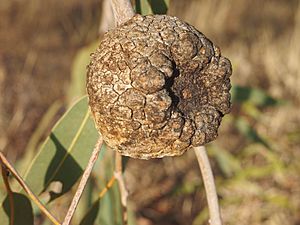Bush coconut facts for kids
The Bush coconut is a really interesting "food" found in Australia. It's also known as the bloodwood apple. It's a special kind of bush tucker, which means it's a traditional food from the Australian bush. Many Indigenous people in Central Australia have eaten it for a very long time.
What makes the Bush coconut so unique is that it's not just a plant part. It's actually a mix of a plant and an animal! Inside, you'll find a tiny insect living there.
What is a Bush Coconut?
The Bush coconut looks like a small, bumpy, woody fruit. It can be about the size of a golf ball or even a tennis ball. If you crack it open, you'll find a milky white inside. This soft part is what the insect and its babies eat.
The "coconut" part is actually a special growth called a gall. This gall grows on a type of eucalypt tree called a bloodwood tree. The insect that lives inside is a female scale insect called Cystococcus pomiformis. She makes the tree grow this gall around her. It's like her cozy, protective home!
How it Forms
When the tiny female Cystococcus pomiformis insect settles on a bloodwood tree, she causes the tree to react. The tree starts to grow a special woody lump around her. This lump is the gall, which we call the Bush coconut. It grows bigger as the insect grows inside. The insect lives there, feeding on the milky white flesh that the tree produces inside the gall.
Eating Bush Coconuts
For the Arrernte people of Central Australia, the Bush coconut is called Merne arrkirlpangkwerle. They know exactly how to find and prepare it.
To eat a Bush coconut, people first pick the gall from the tree. Then, they usually crack it open using a rock. Inside, they find the soft, milky white part and the insect. The Arrernte people call the insect itself angure. Both the soft inner part and the insect are eaten. It's a traditional and important food source.
Its Importance
The Bush coconut is more than just a food. It's an important part of the culture and traditions of Indigenous Australians. Knowing where to find it, how to open it, and how to eat it is knowledge passed down through generations. It shows the deep connection Indigenous people have with their land and its resources.
Images for kids
-
Cluster of bush coconuts (genus Cystococcus) on a bloodwood eucalypt tree (Corymbia)







